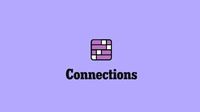Every morning, a growing legion of word puzzle enthusiasts turns to The New York Times for their daily hit of linguistic challenge. On August 25, 2025, the NYT Connections puzzle—number 806—delivered a head-scratching mix of wordplay and clever associations, leaving players alternately delighted and stumped. If you’ve ever wondered what it’s like to navigate the twists and turns of this viral game, today’s edition offered a perfect snapshot of its quirky appeal and the community that has sprung up around it.
Connections, the brainchild of NYT associate puzzle editor Wyna Liu, has quickly become a staple for word lovers, sitting comfortably alongside other Times favorites like Wordle and Spelling Bee. The premise is simple but devilishly tricky: you’re presented with a grid of 16 words, and your mission is to sort them into four groups of four, each united by a common thread. The catch? Sometimes the connections are obvious, but more often, they’re layered with puns, double meanings, or obscure associations that test even the sharpest minds.
According to Lifehacker, Monday’s puzzle was a classic example of the game’s playful misdirection. The four categories for August 25 were: Predicament, Small Spherical Things, Pipe-Smoking Accessories, and What “Down” Might Mean. The words themselves—FIX, JAM, MESS, PICKLE, MOTHBALL, PEA, PEARL, POM-POM, FILTER, LIGHTER, PIPE CLEANER, TAMPER, FEATHERS, GUZZLE, SAD, and WILLING—looked innocent enough at first glance. But, as seasoned Connections solvers know, nothing is ever quite as it seems.
The yellow category, “Predicament,” gathered words that describe a sticky situation: FIX, JAM, MESS, and PICKLE. As Lifehacker explained, this grouping may seem straightforward, but the trick is in the nuance. For instance, FIX doesn’t refer to repairing something—it’s the kind of fix you find yourself in when things go awry, as in, “I’m in a bit of a fix.” Likewise, JAM and PICKLE have double meanings, both as foods and as metaphors for trouble. MESS rounds out the set, a word that’s as much at home describing a cluttered room as it is a complicated problem.
The green category, “Small Spherical Things,” was a bit more concrete: MOTHBALL, PEA, PEARL, and POM-POM. These items share a similar shape, but that’s about where the similarities end. A mothball keeps your sweaters safe, a pea is a staple of the dinner plate, a pearl is a coveted gem, and a pom-pom is more likely to be found on a cheerleader’s costume or a child’s craft project. According to Lifehacker, the connection here is all about their roundness, a visual link that’s easy to miss if you’re caught up searching for deeper meaning.
The blue category, “Pipe-Smoking Accessories,” was where things got a bit more niche. FILTER, LIGHTER, PIPE CLEANER, and TAMPER are all items associated with the ritual of smoking a pipe—a pastime that’s less common these days, given the rise of vaping and cigarettes. Lifehacker noted that some players might initially group FILTER and TAMPER as parts of an espresso machine, and PIPE CLEANER and FEATHERS as crafting supplies. But the real connection is their place in the pipe smoker’s toolkit, a nod to a bygone era of tobacco enjoyment.
The purple category, “What ‘Down’ Might Mean,” was the trickiest of the bunch. FEATHERS, GUZZLE, SAD, and WILLING all relate to different senses of the word “down.” FEATHERS are literally down, as in the soft plumage of birds. GUZZLE refers to “guzzle down,” the act of drinking quickly. SAD captures the emotional sense of feeling down, and WILLING connects to the phrase “down for whatever,” meaning open or enthusiastic about an idea. As Lifehacker put it, “I was onto something with my ‘down’ theory, I just didn’t quite connect the dots.” It’s a reminder that in Connections, wordplay often trumps straightforward logic.
For those new to the game, both Lifehacker and another guide published on August 25 offered a crash course in Connections strategy. The key, they advised, is to expect the unexpected. Categories are designed to overlap, and words that seem to fit one group often belong elsewhere. For example, FILTER and TAMPER could easily be mistaken for coffee equipment, and FEATHERS might seem like a crafting supply rather than a clue to “down.” The best approach? Don’t rush your guesses, and keep an open mind for less obvious associations.
Players are allowed up to four mistakes before the game ends, which adds a layer of suspense—and sometimes, frustration. As one guide put it, “Don’t stress about mistakes: You get four! If you’re like me, you’ll burn through them before breakfast.” The social aspect of Connections is a big part of its appeal. Friends and family often play together, swapping wild guesses and building inside jokes around the game’s more eccentric word pairings. It’s not uncommon for players to see connections everywhere in daily life, from grocery lists to WiFi names, long after the puzzle is solved.
The popularity of Connections speaks to a broader trend in word games: the joy of discovery, the thrill of the “aha” moment, and the communal pleasure of shared puzzling. The game’s official Bot now tracks stats and analyzes scores, adding a competitive edge for those who want to measure their progress. But for most players, the real reward is the satisfaction of cracking a particularly devilish category—or simply surviving to the end with their dignity intact.
As both Lifehacker and the NYT Connections Hints guide emphasized, the fun of Connections lies as much in the journey as in the solution. Whether you’re a first-timer or a seasoned solver, every puzzle offers a fresh opportunity to flex your mental muscles, learn a new word, or just enjoy a few minutes of playful distraction. And if you’re ever stuck, there’s always tomorrow’s puzzle—and a community of fellow word nerds ready to commiserate or celebrate with you.
In the end, the August 25, 2025, edition of NYT Connections was a microcosm of everything that makes the game great: clever word associations, a dash of nostalgia, and a healthy dose of whimsy. For those who cracked the code, it was a satisfying start to the week. For everyone else, there’s always another chance to connect the dots—and maybe, just maybe, to see the world in a slightly more playful way.




